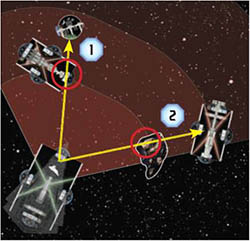
After playing the learning scenario, players are ready to learn the rest of the core rules needed to play a full game of Star Wars: Armada. This includes using obstacles, building fleets, and using objectives.
Line Of Sight And Obstruction
When a ship or squadron attacks, it must trace line of sight from itself to its target. Squadrons and ships have different points from which line of sight is determined, as follows:
Squadron: When tracing line of sight to or from a squadron, trace the line using the point on the squadron's base that is closest to the opposing squadron or hull zone.
Ship: When tracing line of sight to or from a hull zone, the line is traced using the yellow targeting point printed in that hull zone.
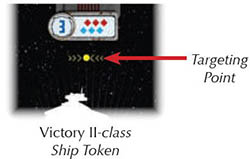
If line of sight is traced through any hull zone on the defending ship that is not the defending hull zone, the attacker does not have line of sight and he must declare another target. If there is no valid target, he cannot perform an attack.
If line of sight is traced through obstacles or ships that are not the attacker or defender, the attack is obstructed. When an attack is obstructed, the attacker rolls one less die of his choice.
Line Of Sight Example
Using the range ruler, the Imperial player traces line of sight from the Victory II-class' front hull zone to three different hull zones on the CR90 Corvette A and to the X-wing squadron.
1He lines up the range ruler between the targeting points on the Victory II-class' front hull zone and the CR90's front hull zone. This line does not pass through another hull zone on the CR90, so the Victory II-class can attack that zone.
2Repeating this process, he finds that the Victory II-class also has line of sight to the CR90's left hull zone.
3He also finds that the Victory II-class does not have line of sight to the CR90's rear hull zone because the line passes through the CR90's left hull zone.
4He traces line of sight to the closest point on the X-wing squadron's base. The X-wing squadron can be targeted by the attack.
Obstruction Example
1The Imperial player traces line of sight to the closest point on the X-wing squadron's base. The line passes through the CR90 Corvette A, so the attack is obstructed.
2The Imperial player traces line of sight to the Nebulon-B's right hull zone. The line passes through an asteroid field, so the attack is obstructed.
Obstacles
Obstacles depict hazards and other space elements that have an impact on the battle. Each obstacle is represented by a token that is placed in the play area. Each type of obstacle affects squadrons and ships as described below.

Asteroid Field
A ship that overlaps this obstacle receives 1 faceup damage card. Squadrons are unaffected.

Debris Field
A ship that overlaps this .ft obstacle suffers 2 damage on any hull zone. Squadrons are unaffected.

Station
A ship that overlaps this obstacle may discard one of its faceup or facedown damage cards. A squadron that overlaps this obstacle may recover one hull point.
Ships and squadrons can move through obstacles without issue; only the final position of the ship or squadron matters.
Fleet-Building Rules
To play a full game of Star Wars: Armada, each player chooses the ships, squadrons, and upgrades that he wishes to use.
All ship, squadron, and upgrade cards display a number in the lower-right corner. This is the fleet point cost of the ship or upgrade, or for each squadron of that type.

Before playing a game, both players must build a fleet. They do this by choosing any number of ship cards, squadron cards, and upgrade cards whose combined fleet point cost does not exceed 300 fleet points.
Players build fleets without any foreknowledge of their opponents' fleet. During the "Gather Components" step of setup, they simultaneously reveal the cards, ships and squadrons in their fleet.
Unique Names
This game includes many famous characters and ships from the Star Wars universe. Each of these famous figures is represented by a card with a unique name, which is identified by a bullet (). to the left of the name. A player cannot field two or more cards that share the same unique name.
Squadron Cards
Squadrons of the same type share a single squadron card. The fleet point cost on squadron cards indicates the cost for one squadron of that type; the player must pay the fleet point cost for each squadron of that type that he wants to field.
Some squadron cards have unique names; these correspond to famous pilots from the Star Wars universe. These pilots lead powerful squadrons that have extra abilities and defense tokens to separate them from common squadrons. A unique squadron uses its own squadron card instead of the shared card for that type.
A player can field only one copy of each unique squadron. Unique squadrons use the reverse side of the squadron disk of their type, which displays the art piece shown on the unique squadron card.
Building fleets using only the core set
In a normal game of Star Wars: Armada, each player builds a fleet using his own collection of ships and components before playing the game.
If players only have a single core set, they may choose to share the components. Due to component limitations, they must choose one player to receive all Rebel cards and give all Imperial cards to the other player. Then all remaining upgrade cards are shuffled up and dealt randomly to the players.
Then players secretly and simultaneously build 180 point fleets before setting up the game.
Upgrade Cards
Players can equip their ships with upgrades such as ion cannons and famous admirals. The upgrade bar along the bottom of each ship card displays icons that represent which upgrades that ship can equip. For each icon shown in the upgrade bar, the ship can equip one upgrade card with the matching icon.
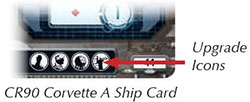
Faction-specific Upgrades
Upgrade cards can be used by ships of any faction unless they have a faction symbol next to the card's fleet point cost. A card with a Rebel symbol can only be equipped in a Rebel fleet, and a card with an Imperial symbol can only be equipped in an Imperial fleet.

Modification Upgrades
Some upgrade cards have the "Modification" trait. A ship cannot equip more than one upgrade with the "Modification" trait.
Titles
Title upgrade cards display a specific ship icon in the lower-left corner. A title card can only be equipped to a ship with the matching ship icon. A ship cannot equip more than one title card.
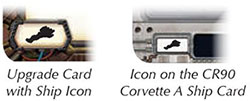
Commanders
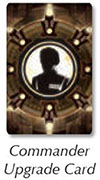
Commander upgrade cards have the T icon on their card backs and no icon in the lower-left corner.
Any ship can equip a commander card regardless of the icons on its upgrade bar, but it cannot equip more than one commander card. A ship with a commander card equipped is a flagship.
Using Upgrade Cards
Many upgrade card effects have a specific time during the game when they occur, which is described on the card. Some cards use a header to indicate when the card can be used as described below:
- Effects that modify attack dice, such as by adding, changing, or rerolling dice, may be resolved after the attack dice are rolled.
 effects are critical effects;
effects are critical effects; and other effects with the icon of a command as a header may resolve while the ship is resolving the matching command.
and other effects with the icon of a command as a header may resolve while the ship is resolving the matching command.
Some card effects require the player to exhaust the card. To exhaust a card, rotate it 90° clockwise.
An exhausted card cannot be exhausted again, preventing the ship from using any effects that require it to exhaust the card. During the Status Phase, all upgrade cards are readied by rotating the cards 90° counterclockwise. Readied cards can be exhausted again.
Scoring Upgrade Cards
When players determine their scores at the end of the game, the total fleet point cost of all upgrade cards equipped to a ship are added to that ship's fleet point cost.
Fleet-building Restrictions
In addition to the rules described earlier in this section, a fleet must abide by these restrictions:
The fleet must be either Rebel-aligned or Imperial- aligned. It cannot contain any ships, squadrons, or upgrades that are aligned with the opposing faction as indicated by the presence of that faction's symbol on those cards.
The fleet must have one flagship (a ship equipped with a commander card). It cannot have more than one flagship.
A ship cannot include more than one copy of the same upgrade card.
The fleet cannot spend more than one third of its fleet points on squadrons.
A fleet must include three objective cards, one from each category.
Critical Effects
Critical effects are devastating effects that the attacker can resolve during an attack before totaling the damage amount. He must have at least one E icon in his attack pool. The attacker can resolve only one critical effect per attack.

Critical effects on upgrade cards are indicated by the  header. Some critical effects on upgrade cards also specify a color; to resolve a critical effect with a color requirement, the E icon must be on a die of that color.
header. Some critical effects on upgrade cards also specify a color; to resolve a critical effect with a color requirement, the E icon must be on a die of that color.
The standard critical effect is:  . If the defender is dealt at least one damage card by this attack, deal the first damage card faceup.
. If the defender is dealt at least one damage card by this attack, deal the first damage card faceup.
Squadrons cannot resolve or suffer critical effects unless otherwise specified.
ID Tokens
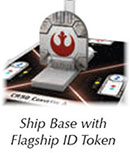
Players must use ID tokens to identify their flagships and to differentiate multiple copies of the same ship.
This is important for tracking which upgrade cards, damage cards, and command dials are assigned to each ship.
To assign an ID, insert a ship ID token into the slot behind the ship's support pole or fin. Then place the matching main ship ID token on that ship's card.
Objectives
Objective cards add variety to each battle by providing a narrative for why the Rebel and Imperial forces are clashing while also changing how players score points. There are three categories of objectives:

Assault:
Assault objectives typically identify one or more ships that are worth extra fleet points when damaged or destroyed.

Defense
Defense objectives alter the play area to provide a significant advantageto one player.

Navigation:
Navigation objectives reward players who maneuver aggressively and precisely.
Objective cards may describe special setup rules which must be followed during the setup process.
They also may include special rules that must be used when playing with that objective. Some objectives allow players to collect victory tokens to increase their score; at the end of the game, each victory token is worth the fleet point value listed in the lower-right corner of the objective card.
Using Objective Cards
As part of the fleet-building process, each player chooses three objective cards. Each objective card must be from a different category. This means that each player brings three objective cards to the game.
During the "Choose Objective" step of setup, the first player (the player with initiative) looks at all three of the second player's objective cards and chooses one of those cards to be the objective for the game. The second player's remaining objective cards and the first player's objective cards are not used this game.
Random Objective Card
If playing with only the core set, the players should randomly determine the objective for the game. During the "Choose Objective" step of setup, the second player shuffles all of the objective cards into a single deck. Then he draws two objectives cards and chooses one to use for the game.
Continue Reading

